
This parent guide supports parents in helping their child at home with the 6th grade Social Studies content.
- Subject:
- Social Studies
- Material Type:
- Reference Material
- Vocabulary
- Author:
- Kelly Rawlston
- Letoria Lewis
- Date Added:
- 10/12/2022

This parent guide supports parents in helping their child at home with the 6th grade Social Studies content.

This resource accompanies our Rethink 6th Grade Social Studies course. It includes ideas for use, ways to support exceptional children, ways to extend learning, digital resources and tools, tips for supporting English Language Learners and students with visual and hearing impairments. There are also ideas for offline learning.

Containing more than 50 articles from the award-winning Tar Heel Junior Historian magazine and over 40 lesson plans, this multidisciplinary Educator Notebook will enrich your exploration of North Carolina and American history with diverse perspectives. This resource's link takes you to a very short form that gives you free downloadable access to the complete PDF book.

A website resource that provides facts and data that documents the forced removal of enslaved persons from Africa and their arrival to North Carolina.

In this lesson, students will understand how ancient civilizations developed based on the local physical features and how the boundaries of early civilizations compare to their modern counterparts.

Before we can begin to study the first peoples, it is important to establish the concept of time. Historians use timelines to help aid in the understanding of the time frame in which the topic under study has taken place. The first step is to establish how the past is organized into sections of time. The organization of time into Eras is a choice made by historians. The sections of time that are being used in this book are divided by major turning points (big events that change humans forever) in history. This book is organizing the major Eras into the following four categories: Prehistory, Ancient History, Middle Ages, and Modern History.

What is an empire? How did they grow? What did they do? How did they work? Why do they decline and fall? These are some of the questions that historians have studied and tried to figure out for centuries. In this chapter you will learn about the difference between a civilization and an empire, the characteristics of empires, the impact of geography on civilizations and empires, how trade developed, and how empires were governed. Finally you will look at some examples of empires from this age.

In this activity, students simulate some of the effects of the Plague in Europe.

In this inquiry, students consider the causes, symptoms, and reasons for the rapid geographic expansion of the disease and how this pandemic affected people of the 14th century and beyond. Through their investigation of sources in this inquiry, students should develop an understanding of the consequences of the Black Death and an informed awareness of the importance of preparing for future diseases and possible pandemics.
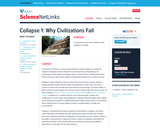
In this lesson, students learn about factors that cause major social changes and about prerequisites for a society’s survival.
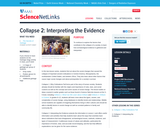
Using an interactive that explores four ancient civilizations - The Maya, Mesopotamia, Chaco Canyon, and Mali/Songhai, students will evaluate and analyze what happens when a society collapses and how archaeologists find and interpret evidence.
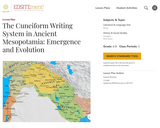
This lesson plan, intended for use in the teaching of world history in the middle grades, is designed to help students appreciate the parallel development and increasing complexity of writing and civilization in the Tigris and Euphrates valleys in ancient Mesopotamia.

In this inquiry, students examine the extent to which the Chinese and Romans had knowledge of and interacted with one another. This inquiry is about the historical antecendent to the Silk Road.

In this 5E lesson, students will be able to describe the effects of geological events on ancient civilizations.

For this activity, students read and interpret a data visualization depicting percentage-point changes in the black population in cities during two major waves of migration.
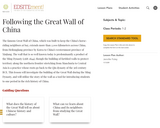
Upon completion of this lesson students will become more familiar with Chinese geography by mapping the path of the wall. They will also explain the construction of the Great Wall as a product of the period in which it was built and discuss in brief the dynasty- the Ming Dynasty- during which major construction on the wall was completed. Students will then identify reasons for the dedication of significant resources to the construction of the wall and discuss in brief China's neighbors to the north, in particular the Mongols and Manchus.
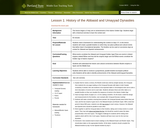
This lesson begins a 5-day unit on achievements of the Islamic Golden Age. Students begin with a historical overview to learn the context and sequence of events that follow. Students need a framework for understanding the content on days 2-5. In this lesson, students will create a parallel timeline on which they can place political and cultural events that define Islam's foundational dynasties. The timeline can be used on successive days as context for Abbasid and Spanish achievements. Students will be able to construct a proportional, parallel timeline to compare political units. Students will be able to identify achievements of the Abbasid and Umayyad Dynasties.
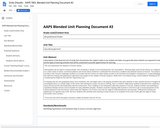
This unit emphasizes the diaspora of human history.
Sixth graders are by nature a myopic people, and constantly in danger of not examining their own assumptions. Teaching large scale human history as a beginning to a closer study of culture, movement patterns and events allows students to understand the miraculous conditions that allowed humans to flourish. The perspective we take in this unit also challenges students to consider that the choices we make always provide a set of positive and negative consequences. In past pedagogy, the shift from hunting and gathering to agriculture was taught as the catalyst of human progress. While that is not entirely wrong, it limits students' thinking by not considering the things we lost with this "opportunity cost."
In keeping with the new geography-heavy 2015 standards, this unit begins with a role-playing simulation that asks students to learn specific biomes to imagine they are plopped down in a certain region of the world, with nothing but a basic tool kit (no clothing, food, or shelter!). Right away students understand the complexity of early survival and the interrelationship with the environment. Then, building on the interpretive skills they learned in Unit one, student examine cave paintings to hypothesis lifestyle choices and necessities for early paleolithic peoples. Students recall the mapping skills learned in Unit One to get a visual perspective of the human diaspora in the next lesson, which maps the migration out of Africa, and sets the stage to understanding the next big topic: shifting from hunting and gathering to an agrarian way of life. But first, students will culminate their learning of early humans in an analysis of the issue of who gets the rights to study Kennewick man's remains.
**From the new AAPS 6th grade curriculum; written by Rachel Toon for ATLAS

Students will explain factors that influenced the movement of people over time by examining the correlation between indentured servitude in the early American colonies and undocumented immigration today. They will understand how demographic trends, such as push and pull factors, lead to conflict, negotiations, and compromise in modern societies.

Students will read a passage and write to answer questions based on the passage. This resource supports English language development for English language learners.